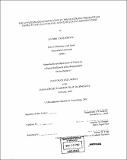| dc.contributor.advisor | Timothy M. Swager. | en_US |
| dc.contributor.author | Simone, Davide Louis, 1973- | en_US |
| dc.contributor.other | Massachusetts Institute of Technology. Dept. of Chemistry. | en_US |
| dc.date.accessioned | 2005-08-23T19:32:36Z | |
| dc.date.available | 2005-08-23T19:32:36Z | |
| dc.date.copyright | 2002 | en_US |
| dc.date.issued | 2002 | en_US |
| dc.identifier.uri | http://hdl.handle.net/1721.1/8365 | |
| dc.description | Thesis (Ph.D.)--Massachusetts Institute of Technology, Dept. of Chemistry, 2002. | en_US |
| dc.description | Vita. | en_US |
| dc.description | Includes bibliographical references. | en_US |
| dc.description.abstract | Scope. The body of work described in this thesis focuses on the synthesis of donor-acceptor architectures of the pseudorotaxane, rotaxane, and catenane genres. The binding constants of thiophene and phenylene-ethynylene based crown ethers are determined via fluorescence quenching titrations, in an attempt to correlate structure with binding affinities. The insight obtained from the binding constant determinations allows for the proper choice of crown ether for the formation of [2]-catenanes and [2]-rotaxanes. The electronic properties of these complexes are then probed by electrochemical, spectroelectrochemical, and conductivity measurements. The potential of a poly([2]-catenane) as a photoconductive polymer is also investigated. The obstacles encountered in synthesizing poly([2]-rotaxanes) is also discussed, with emphasis on end-group strategies that aid in thwarting electrochemically induced dethreading. Chapter 1. This chapter provides a broad overview of the physical methods utilized in this thesis. Electrochemical methods are covered, with particular emphasis on oxidative polymerization of heteroaromatic monomers. Correlation between electrode phenomena and cyclic voltammogram waveshapes is included, in order to reinforce an understanding of the various electrochemical processes. Electroactive catenane and rotaxane supramolecules feature prominent in the literature, and a brief overview of significant examples is given. Advanced electrochemical techniques regarding in-situ conductivity measurements and spectroelectrochemistry are discussed. The elucidation of binding affinities for hosts and guest via fluorescence spectroscopy, a major theme in Chapter 2, is presented with focus on interpreting Stern-Volmer plots. | en_US |
| dc.description.abstract | (cont.) A lengthy discussion of photovoltaic devices emphasizing I-V, C-V, and photoaction spectra interpretation is presented with relevant literature examples. Chapter 2. The synthesis of halo-functionalized crown ethers and efforts toward improving reaction yields for the macrocyclization are presented. Subsequent functionalization of the crown ethers with acetylide and thiophene groups via cross-coupling reactions, provides a wealth of receptors for the analyte paraquat. The affinities of the macrocycles for paraquat are determined through Stern-Volmer fluorescence quenching experiments. Correlations between structure and binding constants indicate that a-stacking interactions in two parallel planes, as seen for thiophene derivatized crown ether 33, affords the greatest complimentarity with paraquat, Ksv = 9665 +/- 179M-1. Acetylide functionalized crown ethers tend to have the weakest binding affinities, attributed to the poorer - extension. Increasing the electron-donating nature of the thiophene function as seen for 23 versus 15 leads to the doubling of the binding constant. Multiple crown ether receptor 29 does not display a non-linear Stern-Volmer plot, indicating that a single binding event occurs for this molecule. Relative to its monocrown analog 25, the binding constant for 29 is 1.2x larger, hinting at cooperativity between crown ether units. Chapter 3. Electrochemical studies on [2]-catenane 38, its non-catenated analog 23, and their respective polymers are undertaken in an effort to quantify the electronic disparity between the differing architectures ... | en_US |
| dc.description.statementofresponsibility | by Davide Louis Simone. | en_US |
| dc.format.extent | 244 leaves | en_US |
| dc.format.extent | 11490047 bytes | |
| dc.format.extent | 11489801 bytes | |
| dc.format.mimetype | application/pdf | |
| dc.format.mimetype | application/pdf | |
| dc.language.iso | eng | en_US |
| dc.publisher | Massachusetts Institute of Technology | en_US |
| dc.rights | M.I.T. theses are protected by copyright. They may be viewed from this source for any purpose, but reproduction or distribution in any format is prohibited without written permission. See provided URL for inquiries about permission. | en_US |
| dc.rights.uri | http://dspace.mit.edu/handle/1721.1/7582 | |
| dc.subject | Chemistry. | en_US |
| dc.title | The synthesis and investigation of the electronic properties of crown ether, [2]-catenane, and [2]-rotaxane architectures | en_US |
| dc.type | Thesis | en_US |
| dc.description.degree | Ph.D. | en_US |
| dc.contributor.department | Massachusetts Institute of Technology. Department of Chemistry | |
| dc.identifier.oclc | 50549631 | en_US |
